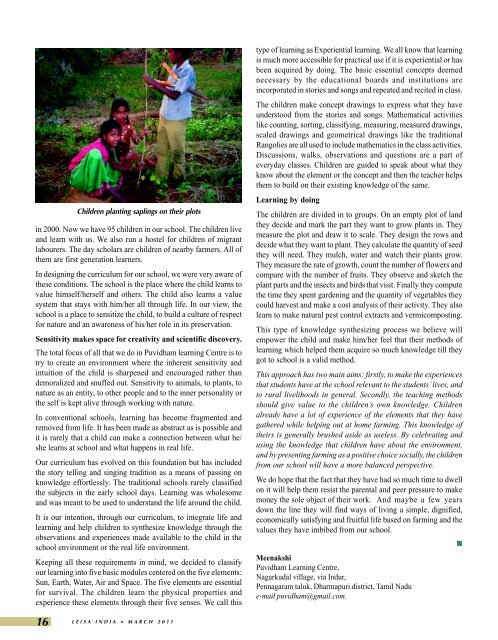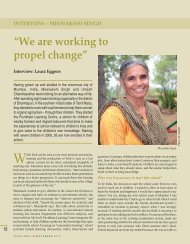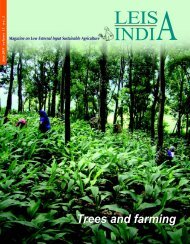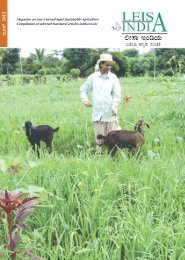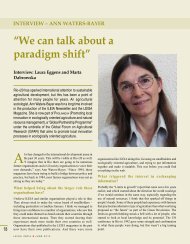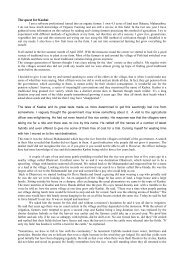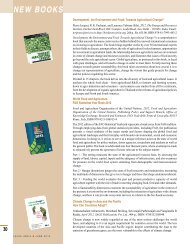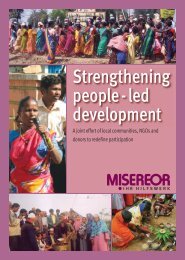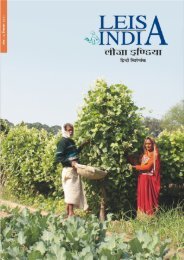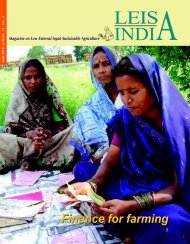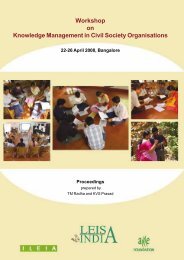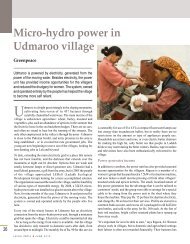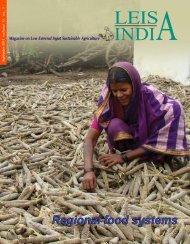Low external input sustainable agriculture - Leisa India
Low external input sustainable agriculture - Leisa India
Low external input sustainable agriculture - Leisa India
You also want an ePaper? Increase the reach of your titles
YUMPU automatically turns print PDFs into web optimized ePapers that Google loves.
16Children planting saplings on their plotsin 2000. Now we have 95 children in our school. The children liveand learn with us. We also run a hostel for children of migrantlabourers. The day scholars are children of nearby farmers. All ofthem are first generation learners.In designing the curriculum for our school, we were very aware ofthese conditions. The school is the place where the child learns tovalue himself/herself and others. The child also learns a valuesystem that stays with him/her all through life. In our view, theschool is a place to sensitize the child, to build a culture of respectfor nature and an awareness of his/her role in its preservation.Sensitivity makes space for creativity and scientific discovery.The total focus of all that we do in Puvidham learning Centre is totry to create an environment where the inherent sensitivity andintuition of the child is sharpened and encouraged rather thandemoralized and snuffed out. Sensitivity to animals, to plants, tonature as an entity, to other people and to the inner personality orthe self is kept alive through working with nature.In conventional schools, learning has become fragmented andremoved from life. It has been made as abstract as is possible andit is rarely that a child can make a connection between what he/she learns at school and what happens in real life.Our curriculum has evolved on this foundation but has includedthe story telling and singing tradition as a means of passing onknowledge effortlessly. The traditional schools rarely classifiedthe subjects in the early school days. Learning was wholesomeand was meant to be used to understand the life around the child.It is our intention, through our curriculum, to integrate life andlearning and help children to synthesize knowledge through theobservations and experiences made available to the child in theschool environment or the real life environment.Keeping all these requirements in mind, we decided to classifyour learning into five basic modules centered on the five elements:Sun, Earth, Water, Air and Space. The five elements are essentialfor survival. The children learn the physical properties andexperience these elements through their five senses. We call thisLEISA INDIA • MARCH 2011type of learning as Experiential learning. We all know that learningis much more accessible for practical use if it is experiential or hasbeen acquired by doing. The basic essential concepts deemednecessary by the educational boards and institutions areincorporated in stories and songs and repeated and recited in class.The children make concept drawings to express what they haveunderstood from the stories and songs. Mathematical activitieslike counting, sorting, classifying, measuring, measured drawings,scaled drawings and geometrical drawings like the traditionalRangolies are all used to include mathematics in the class activities.Discussions, walks, observations and questions are a part ofeveryday classes. Children are guided to speak about what theyknow about the element or the concept and then the teacher helpsthem to build on their existing knowledge of the same.Learning by doingThe children are divided in to groups. On an empty plot of landthey decide and mark the part they want to grow plants in. Theymeasure the plot and draw it to scale. They design the rows anddecide what they want to plant. They calculate the quantity of seedthey will need. They mulch, water and watch their plants grow.They measure the rate of growth, count the number of flowers andcompare with the number of fruits. They observe and sketch theplant parts and the insects and birds that visit. Finally they computethe time they spent gardening and the quantity of vegetables theycould harvest and make a cost analysis of their activity. They alsolearn to make natural pest control extracts and vermicomposting.This type of knowledge synthesizing process we believe willempower the child and make him/her feel that their methods oflearning which helped them acquire so much knowledge till theygot to school is a valid method.This approach has two main aims: firstly, to make the experiencesthat students have at the school relevant to the students’ lives, andto rural livelihoods in general. Secondly, the teaching methodsshould give value to the children’s own knowledge. Childrenalready have a lot of experience of the elements that they havegathered while helping out at home farming. This knowledge oftheirs is generally brushed aside as useless. By celebrating andusing the knowledge that children have about the environment,and by presenting farming as a positive choice socially, the childrenfrom our school will have a more balanced perspective.We do hope that the fact that they have had so much time to dwellon it will help them resist the parental and peer pressure to makemoney the sole object of their work. And maybe a few yearsdown the line they will find ways of living a simple, dignified,economically satisfying and fruitful life based on farming and thevalues they have imbibed from our school.MeenakshiPuvidham Learning Centre,Nagarkudal village, via Indur,Pennagaram taluk, Dharmapuri district, Tamil Nadue-mail puvidham@gmail.com.•


